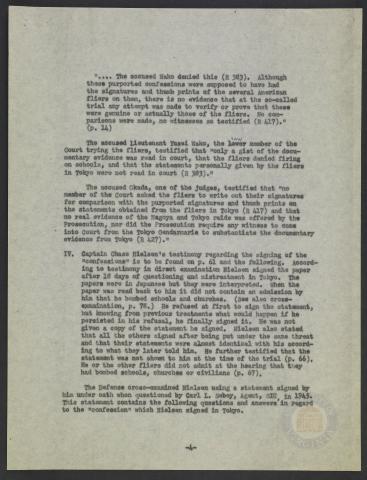
Page 4
| Parent | Circumstances surrounding the "confessions" of the Doolittle flyers |
|---|---|
| Date | 16 September 1947 |
| Language | English |
| Collection | Tavenner Papers & IMTFE Official Records |
| Box | Box 5 |
| Folder | General Memoranda and Reports from September 1947 |
| Repository | University of Virginia Law Library |
?Ç£. . . . The accused Wako denied this (R 383). Although these purported confessions were supposed to have had the signatures and the thumb prints of the several American fliers on them, there is no evidence that at the so-called trial any attempt was made to verify or prove that these were genuine or actually those of the fliers. No comparisons were made, no witnesses so testified (R 417).?Ç¥ (p. 14) The accused Lieutenant Yusei Wako, the law member of the Court trying the fliers, testified that ?Ç£only a gist of the documentary evidence was read in court, that the fliers denied firing on schools, and that the statements personally given by the fliers in Tokyo were not read in court (r 383).?Ç¥ The accused Okada, one of the judges, testified that ?Ç£no member of the Court asked the fliers to write out their signatures for comparison with the purported signatures and thumb prints on the statements obtained from the fliers in Tokyo (R 417) and that no real evidence of the Nagoya and Tokyo raids was offered by the Prosecution, nor did the Prosecution require any witness to come into Court from the Tokyo Gendarmarie to substantiate the documentary evidence from Tokyo (R 427).?Ç¥ IV. Captain Chase Nielsen?ÇÖs testimony regarding the signing of the ?Ç£confessions?Ç¥ is to be found on p. 61 and the following. According to testimony in direct examination Nielsen signed the paper after 18 days of questioning and mistreatment in Tokyo. The papers were in Japanese but they were interpreted. When the paper was read back to him it did not contain an admission by him that he bombed schools and churches. (See also cross-examination, p. 78.) He refused at first to sign the statement, but knowing from previous treatments what would happen if he persisted in his refusal, he finally signed it. He was not persisted in his refusal, he finally signed it. It was no given a copy of the statement he signed. Nielsen also stated that all the others signed after being put under the same threat and that their statements were almost identical with his according to what they later told him. He further testified that the statement was not shown to him at the time of the trial (p. 66). HE or the other fliers did not admit at the hearing that they had bombed schools, churches or civilians (p. 67). The Defense cross-examined Nielsen using a statement signed by him under oath when questioned by Carl L. Sebey, Agent, SIC, in 1945. This statement contains the following questions and answers in regard to the ?Ç£confession?Ç¥ which Nielsen signed in Tokyo. -4-
